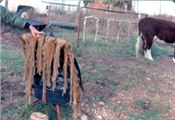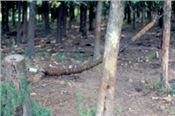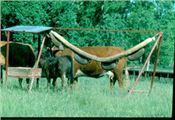History Provides A Perspective On Who Is Winning, The Flies Or Cattle Producers?
MT. VERNON, MO.
The early warm-up and early appearance of flies on cattle have led to numerous questions about horn and face fly control according to Eldon Cole, a livestock specialist with University of Missouri Extension.
Horn flies are bloodsuckers and can contribute to lower rates of gain in cattle. The greatest concern about face flies is their transmission of pinkeye from animal to animal. These stressors result in a significant economic loss in cattle.
“All of the questions have caused me to go back a number of years to learn past recommendations for pesticides and innovative methods that have been used to deliver the insecticides to repel both flies,” said Cole.
Fly control in the mid-1900's relied primarily on products that were applied via sprays.
“Most of those products are no longer available. They were quite effective at the time if applied on a regular basis,” said Cole.
The use of back rubbers then came along, and some of the same insecticides used earlier as a spray were now mixed with diesel and applied to homemade burlap rubs. The rubs were located were cattle were forced to use them every day or two. Hanging them across gates or even between trees where the cattle moved to water or mineral were favorite locations.
“Farmers liked this method as it reduced the labor of spraying plus not everyone owned a sprayer. Control was excellent for horn flies,” said Cole.
According to Cole, face flies did not seem as prevalent then but as their numbers increased farmer ingenuity took over with add-ons to the rubs.
“About that time, dust bags came out, and farmers felt this might be more effective for face flies. Some cattlemen did not even put the dust in the bag they threw the dust on the cattle,” said Cole.
In the 1970’s and 1980’s, there was limited use of oral larvacides with mixed results according to Cole. As time passed, this method found wider acceptance which improved the usefulness of the feed-throughs. In this period, there was an oral larvicide administered as a bolus.
“In the late 1970’s the insecticide impregnated fly control ear tags became the rage and new savior of beef cattle from flies. Unfortunately, ear tags were so popular they were sometimes misused by being applied too early in the season or left in for a year,” said Cole.
As resistance problems grew, new insecticides and blends were introduced. Rotating the products has helped the tag program still be effective. Even this year, Cole notes, new products have been introduced.
Pour on, mist applicators, spot on applied by a gun and even walk-through fly traps have had moments of success. The latter appeals to all-natural and organic producers but probably only give 50 to 60 percent horn fly control.
“Perhaps we have not won the fly war yet, but you cannot say the researchers at universities and animal health industries have not tried. I am intrigued by research that is looking at genomics as a means of identifying animals that have genetic resistance to flies,” said Cole.
Some of the first work in genomics was published by Arkansas researchers in the early 1990s.
“As you employ your chosen fly control practices this year, pay attention to those animals that seem to have significantly fewer flies and those that seem to be fly magnets. Write it down so you will not forget it,” said Cole.
The economic threshold for serious losses in animal performance seems to be 200 horn flies per head. Cole notes that a few flies should not upset the cattle producer or the cattle.
“There are many items that help you fight the fly battle, and you can take your pick depending on your situation. In fact, one single method is probably not the answer,” said Cole. ∆

A portable backrubber and mineral feeder

A homemade backrubber hung between two trees

Attachments to mineral feeder for face fly control